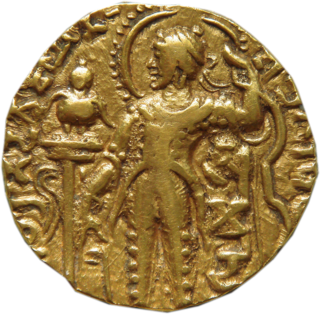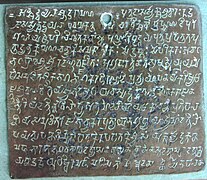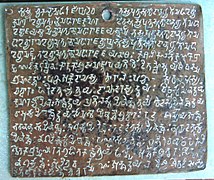
Chandragupta II, also known by his title Vikramaditya, as well as Chandragupta Vikramaditya, was the third ruler of the Gupta Empire in India. Modern scholars generally identify him with King Chandra of the Delhi iron pillar inscription.

Samudragupta (Gupta script: Sa-mu-dra-gu-pta, was the second emperor of the Gupta Empire of ancient India, and is regarded among the greatest rulers of India. As a son of the Gupta emperor Chandragupta I and the Licchavi princess Kumaradevi, he greatly expanded his dynasty's political and military power.

Kumaragupta I was an emperor of the Gupta Empire of Ancient India. A son of the Gupta emperor Chandragupta II and Queen Dhruvadevi. He seems to have maintained control of his inherited territory, which extended from Gujarat in the west to Bengal region in the east.

Gupta was the founder of the Gupta dynasty of northern India. He is identified with king Che-li-ki-to, who, according to the 7th-century Chinese Buddhist monk Yijing, built a temple near Mi-li-kia-si-kia-po-no (Mṛgaśikhāvana) for Chinese pilgrims.

The Vakataka dynasty was an ancient Indian dynasty that originated from the Deccan in the mid-3rd century CE. Their state is believed to have extended from the southern edges of Malwa and Gujarat in the north to the Tungabhadra River in the south as well as from the Arabian Sea in the west to the edges of Chhattisgarh in the east. They were the most important successors of the Satavahanas in the Deccan and contemporaneous with the Guptas in northern India.

Dakshina Kosala is a historical region of central India. It was located in what is now Madhya Pradesh and Chhattisgarh along with parts of Western Odisha. At its greatest extent, it may have also included a part of the Vidarbha region in present-day Maharashtra.

The Salankayana dynasty of ancient India ruled a part of Andhra region in India from 300 to 440 CE. Their territory was located between the Godavari and the Krishna rivers. Their capital was located at Vengi, modern Pedavegi near Eluru in West Godavari district of Andhra Pradesh.
The Andhra Ikshvaku dynasty ruled in the eastern Krishna River valley of India, from their capital at Vijayapuri for over a century during 3rd and 4th centuries CE. The Ikshvakus are also known as the Ikshvakus of Vijayapuri to distinguish them from their legendary namesakes.

Ghatotkacha was a pre-imperial Gupta king of northern India. He was a son of the dynasty's founder Gupta, and the father of the dynasty's first emperor Chandragupta I.
The Katni copper-plate of Jayanātha is an epigraphic record documenting the donation of the village of Kalabhikuṇḍaka in the time of the Uccakalpa ruler mahārāja Jayanātha. It is dated year 182 in the Gupta era.

The Naga dynasty ruled parts of north-central India during the 3rd and the 4th centuries, after the decline of the Kushan Empire and before the rise of the Gupta Empire. Its capital was located at Padmavati, which is identified with modern Pawaya in Madhya Pradesh. Modern historians identify it with the family that is called Bharashiva in the records of the Vakataka dynasty.

The Bhanja dynasty is a dynasty that originated in the northern and central regions of modern Odisha before the Gupta Empire became an imperial power. The dynasty, of ancient local Kshatriya lineage as documented by Hermann Kulke, succeeded the Vindhyatabi branch of the Nagas of Padmavati, who ruled from the Keonjhar district of Odisha and included Satrubhanja of the Asanpat inscription. The Bhanj later became feudatories of the Bhauma-Kara dynasty.

Pravarasena II was a ruler of the Nandivardhana-Pravarapura branch of the Vakataka dynasty. He was the son of Rudrasena II and Prabhavatigupta, the daughter of the Gupta emperor Chandragupta II. He succeeded his brother Damodarasena as Maharaja. Pravarasena's reign seems to have been mostly peaceful and prosperous, and is noted for an efflorescence of religious patronage.
The Parivrajaka dynasty ruled parts of central India during 5th and 6th centuries. The kings of this dynasty bore the title Maharaja, and probably ruled as feudatories of the Gupta Empire. The dynasty is known from inscriptions of two of its kings: Hastin and Samkshobha.
Maharaja Hastin was a feudatory of the Gupta Dynasty and a member and ruler of the Parivrajaka dynasty. He is known from the Khoh copper plate land grant, records a land grant of a village to certain brahmanas by him.

The Gupta era is a historical calendar era that begins from c. 318–319 CE. It was used by the Gupta emperors, as well as their vassals and their successors in present-day northern India and Nepal. It is identical to the Vallabhi era, which was used in the Saurashtra region of western India, although regional differences lead to a slightly different calculation for the conversion of Vallabhi era years to Common Era (CE).
Govindagupta was a Gupta prince of ancient India. He was a son of Chandragupta II and Dhruvadevi, and a brother of Kumaragupta.
Vishnugopa was a Pallava king of Kanchi. He was the son of Buddhavarman.
Maharaja Samkshobha was a feudatory of the Gupta Dynasty and a member and ruler of the Parivrajaka dynasty. Maharaja Samkshobha succeeded his father Hastin, and inherited the entire ancestral territory, including the 18 kingdoms. Like his father, he also made land grants for religious merit. He maintained the orthodox varna and ashrama systems.
















